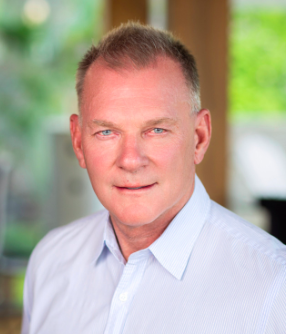It’s a core principle of the Satell Institute, as new member Steve Graham — whose philanthropic support helped break dancing be featured as an Olympic sport in 2024 — can attest.
* * *
A key feature of the Satell Institute’s membership model is choice. While members must commit a minimum of $25,000 per year for four years to at least one nonprofit, the beneficiary is entirely up to them. As SI founder Ed Satell puts it, “The most important nonprofit is the one that impacts your family.”
It’s a sentiment that resonates with new Satell Institute member Steve Graham, head of the private investment firm Graham Partners. “There are a lot of people giving to the causes that are important to them — for whatever reasons,” Graham says.
His own family is a case in point. His father, Donald — an engineer and entrepreneur who founded a mega-successful group of manufacturing businesses known today as The Graham Group — remains active in his 90s, giving to a wide array of nonprofits.
Steve Graham also donates to a multitude of causes, including two that are particularly close to his heart: soccer programs that benefit underserved youth, as well as, of all things, break dancing.
The Graham family’s choices are deeply personal, but they embody what SI champions: the power of free enterprise and Corporate Social Responsibility. Free enterprise organizations not only create more than 80 percent of all jobs in the United States; they generate financial resources that support nonprofits — of many, many different kinds.
In this new conversation, Steve Graham talks about his background, his support of education, soccer and break dancing, and why he’s so excited to be a member of the Satell Institute.
* * *
Going back to high school and college…
…I was an athlete — a downhill ski racer. I grew up in Pennsylvania but left at a really young age to go to a ski racing academy in Vermont called Burke Mountain Academy. And I was also a tournament tennis player. After Burke I went to Williams, and then to Goldman Sachs in New York City as a financial analyst. Then I went back to business school at Dartmouth, and when I got out of business school I got into private equity and private investing.
My dad…
…had started a design engineering business that eventually morphed into several large manufacturing companies. He ended up with three manufacturing platforms — packaging, machinery technology for plastics/composites, and building products.
I eventually joined him, setting up the entity that is today Graham Partners originally to handle the deal-making for the family. After a controlling interest in my father’s packaging company was sold to Blackstone, I pivoted to private equity. Today we’re managing quite a bit of capital, virtually all of it institutional for pension funds, insurance companies, endowments and foundations.
As a family…
…we’ve continued to spawn other entities. All three of my brothers run their own independent private investment firms. And in the next generation there are 17 kids.
The Graham family tradition…
…has always been pretty philanthropic. And so I’ve been impacted by the tradition that my dad and mom started, which was heavy on education, the arts, athletics — those are key areas where the family has been philanthropic.
My own focus…
…has been on a combination of things. I support educational initiatives, largely scholarship funding for under-resourced communities; sports, because I have a sports background and interest. And then some things in the arts, specifically street dance, which I’ve also been a big supporter of.
I like to be involved philanthropically where I can make an impact — not just the dollars, but my own involvement. My dad was the inspiration and has been very similar in his approach, as have other family members. Each of my brothers and my sister have their own independent philanthropic initiatives.
I launched…
…a private foundation called Silverback in 2013, and there are multiple charitable foundations associated with the Graham family. We’re supporting scholarship programming in 10 to 15 schools in the Philadelphia area where we have relationships. We’ve also donated a huge amount philanthropically in support of soccer.
A program I helped create is called…
…The SWAG, which is a no-cost soccer training program focused on kids ages 4 through 9. It operates in North Philadelphia, West Philadelphia, Southwest Philadelphia, and Chester. Something like 95 percent of the kids are of African descent.
We’re investors in the Philadelphia Union, and we have Union coaches, among others, coaching the SWAG kids year-round. About 60 percent of the Union’s Junior Academy players (starting at age 10) now come through The SWAG.
Other SWAG kids get placed into different programs, including soccer clubs and schools. We have SWAG kids who are on full scholarship at The Benchmark School and other schools. And the schools, in turn, are providing field space for our littlest SWAG kids.
I learned to break dance…
…when I was at Goldman in the early ’80s. I’d heard about it when I was in college. I went to this place called the Roxy where the breakers were, and I really got into it.
Spinning the clock forward many years…
…I now give a lot of money philanthropically and through sponsorships to breaking. I helped with the funding for breaking to be featured as an Olympic showcase sport in Paris last year. I have a breaking room here in my house, and I had the US Olympic team training here. And I’m still breaking at my age.
I was introduced to the Satell Institute…
…by SI Vice President Paul Howard, whom I met through the Philadelphia Union Foundation.
When it comes to SI’s mission…
…I got it right away. In a lot of ways it’s a variation of YPO, with CEOs coming together to help the community and themselves. I think the initiatives we’re involved with will resonate with people who are in the Satell Institute’s ecosystem.
I do all this…
…because I want to. What can I get involved with that I like doing — and where I can make an impact? It’s really as simple as that.


